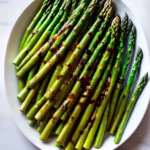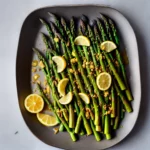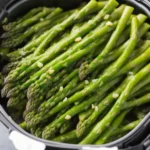Asparagus is a beloved vegetable known for its freshness and taste. However, like any other produce, it can go bad if not properly stored or handled. In this easy guide, I will teach you how to identify if asparagus is bad, providing you with the knowledge to ensure your meals are always fresh and healthy.
Key Takeaways:
- Asparagus can go bad if not stored or handled correctly.
- Signs of bad asparagus include wilting, discoloration, odor, and sliminess.
- Proper storage can extend the freshness of asparagus.
- Asparagus is packed with vitamins, fiber, and antioxidants.
- Selecting fresh asparagus at the grocery store is essential for quality ingredients.
The Importance of Fresh Asparagus in Culinary Delights
Fresh asparagus is a key ingredient in countless culinary creations. Its vibrant green color, tender texture, and unique flavor make it a favorite choice in kitchens worldwide. Whether you’re grilling, roasting, steaming, or incorporating it into delicious recipes, fresh asparagus adds a touch of elegance and freshness to any dish.
When it comes to cooking with asparagus, the possibilities are endless. You can grill it to bring out a smoky flavor, roast it for depth and caramelization, or steam it to maintain its natural sweetness and tenderness. The versatility of fresh asparagus allows you to explore your culinary creativity and experiment with different techniques to create memorable and flavorful meals.
Table: Cooking Methods for Delicious Asparagus Dishes
| Cooking Method | Description |
|---|---|
| Grilling | Brings out a smoky flavor and adds charred marks for aesthetic appeal. |
| Roasting | Creates depth and caramelization, enhancing the natural flavors of asparagus. |
| Steaming | Preserves the natural sweetness and tenderness of asparagus while retaining its vibrant green color. |
By using fresh asparagus in your culinary creations, you can elevate the flavors and textures of your dishes. Its delicate, slightly sweet flavor and tender yet crisp texture add a refreshing element that complements a wide range of ingredients and cuisines. Whether you’re a seasoned chef or an enthusiastic home cook, fresh asparagus is a must-have ingredient in your kitchen.
Signs of Spoilage: How to Spot Bad Asparagus
When it comes to enjoying fresh and delicious asparagus, it’s important to be able to identify the signs of spoilage. By knowing what to look for, you can ensure that you’re only using the highest quality asparagus in your meals.
One of the key indicators of bad asparagus is wilting or drooping spears. Fresh asparagus should have firm and upright spears, so if you notice that they are limp or easily bendable, it’s a sign that the asparagus is past its prime.
Discoloration or browning is another telltale sign of spoilage in asparagus. While some slight discoloration at the base is normal, if you notice extensive browning or any signs of mold, it’s best to discard the asparagus to avoid any potential foodborne illnesses.
Another important aspect to consider is the odor of the asparagus. Fresh asparagus should have a pleasant, earthy smell. However, if you detect a strong or unpleasant odor, it may indicate that the asparagus is no longer fresh and should not be consumed.
Signs of Spoilage: How to Spot Bad Asparagus
| Signs of Spoilage | Description |
|---|---|
| Wilting or drooping spears | Firm and upright spears are a sign of freshness. Wilting or drooping spears indicate that the asparagus has started to spoil. |
| Discoloration or browning | While slight discoloration at the base is normal, extensive browning or signs of mold suggest spoilage. |
| Unpleasant odor | Fresh asparagus should have a pleasant, earthy smell. A strong or unpleasant odor may indicate that the asparagus is no longer fresh. |
| Sliminess | Asparagus should not feel slimy to the touch. If the spears are slimy, it’s a sign of spoilage and should be discarded. |
Lastly, sliminess on the surface of asparagus is a clear sign of spoilage. Fresh asparagus should not feel slimy to the touch, so if you notice any sliminess, it’s best to avoid using it in your dishes.
By being aware of these signs of spoilage, you can confidently select fresh and high-quality asparagus for your meals. Remember to always trust your senses and prioritize your health and safety when it comes to food consumption.
Storage Tips for Keeping Asparagus Fresh
Proper storage is crucial for maintaining the freshness of asparagus. To extend its shelf life, store asparagus in the refrigerator. Trim the ends and place the spears upright in a glass jar filled with an inch of water. Cover the asparagus with a plastic bag to retain moisture and keep it fresh for up to 3-5 days. However, it is always best to consume asparagus as soon as possible for optimal flavor and quality.
Storing Asparagus in the Refrigerator
When storing asparagus, it’s important to keep it cool and moist to preserve its freshness. Follow these steps to ensure your asparagus stays crisp and flavorful:
- Trim the ends: Before storing, trim off the tough ends of the asparagus spears. This helps the asparagus absorb water and prolong its shelf life.
- Arrange upright in a jar: Place the trimmed asparagus spears in a glass jar or container filled with about an inch of water. This allows the asparagus to hydrate and stay fresh.
- Cover with a plastic bag: Loosely cover the jar with a plastic bag to create a humid environment within the refrigerator. This helps retain moisture and prevents the asparagus from drying out.
- Store in the refrigerator: Place the jar of asparagus in the refrigerator, ideally in the vegetable crisper drawer. Keep the temperature set between 32°F (0°C) and 40°F (4°C) to maintain freshness.
Optimizing Shelf Life and Quality
While asparagus can stay fresh for a few days when stored properly, it’s best to consume it as soon as possible for optimal flavor and quality. Here are a few tips to make the most of your asparagus:
- Buy fresh asparagus: Select asparagus with firm stalks and vibrant green color. Avoid any spears that are wilted, discolored, or have a strong odor.
- Trim before use: Prior to cooking or consuming, trim off the tough ends of the asparagus spears. This ensures that you’re working with the most tender and flavorful parts.
- Enjoy quickly: Asparagus is a perishable vegetable, so it’s best to use it within a few days of purchase. The longer it sits, the more its flavor and quality may deteriorate.
By following these storage tips, you can keep your asparagus fresh and ready to be used in a variety of delicious recipes. Whether you’re steaming it as a side dish, grilling it for a summer barbecue, or incorporating it into a stir-fry, fresh asparagus adds a vibrant and nutritious element to your meals. Make the most of this versatile vegetable by properly storing it and savoring its freshness.
The Nutritional Value of Asparagus
Asparagus is not only a delicious addition to meals, but it also packs a nutritional punch. These vibrant green spears are rich in vitamins and minerals, making them a healthy choice for any diet. Here are some of the key nutritional benefits of asparagus:
Vitamins
Asparagus is a great source of vitamins A, C, and K. Vitamin A promotes healthy vision and a strong immune system, while vitamin C boosts collagen production and supports immune function. Vitamin K plays a role in blood coagulation and bone health. Incorporating asparagus into your meals can help you meet your daily vitamin needs.
Folate
Asparagus is also high in folate, a B-vitamin that is essential for cell growth and development. Folate is particularly important for pregnant women, as it helps prevent neural tube defects in the developing fetus. Adding asparagus to your diet is a delicious way to increase your folate intake.
Fiber
Asparagus is a good source of dietary fiber, which supports healthy digestion and can help manage weight. Fiber adds bulk to the diet, promoting feelings of fullness and preventing overeating. Including asparagus in your meals can help you maintain a healthy digestive system.
Overall, asparagus is a nutritious green vegetable that offers a range of health benefits. Whether you enjoy it steamed, roasted, or grilled, you can savor the delicious flavor of asparagus while nourishing your body with its valuable nutrients.
| Nutrient | Amount per 100g |
|---|---|
| Calories | 20 |
| Protein | 2.2g |
| Carbohydrates | 3.7g |
| Fiber | 2.0g |
| Fat | 0.2g |
| Vitamin A | 756 IU |
| Vitamin C | 5.6 mg |
| Vitamin K | 41.6 mcg |
| Folate | 52 mcg |
| Potassium | 202 mg |
Selecting Fresh Asparagus at the Grocery Store
When it comes to grocery shopping for asparagus, selecting the freshest and highest quality spears is key. By following a few simple tips, you can ensure that you bring home the best asparagus for your meals.
First and foremost, look for asparagus with firm, bright green stalks. The spears should be free from wilting or drooping, as this is a sign of poor quality. Additionally, check the tips of the asparagus to ensure they are tight and compact. Avoid spears with any signs of discoloration or browning, as this indicates that they may not be fresh.
It’s also important to choose asparagus that is uniform in size. This will ensure that the spears cook evenly and have a consistent texture. Whether you’re planning to grill, roast, or steam your asparagus, selecting spears of the same size will result in a more visually appealing and delicious dish.
By being selective at the grocery store and paying attention to these tips, you can enjoy the freshest and most flavorful asparagus in your meals. So the next time you’re shopping for produce, keep these guidelines in mind to ensure that your asparagus is of the highest quality.
Table: Tips for Selecting Fresh Asparagus
| Tip | Description |
|---|---|
| Look for firm stalks | Choose asparagus with stalks that are firm to the touch. Avoid any that feel soft or limp. |
| Check the tips | Inspect the tips of the asparagus spears to ensure they are tight and compact. |
| Avoid discoloration | Avoid asparagus with any signs of discoloration or browning, as this indicates it may not be fresh. |
| Select uniform size | Choose asparagus spears that are uniform in size for even cooking and a consistent texture. |
Culinary Delights: Embracing the Season of Spring with Asparagus
As a lover of culinary arts, I find great joy in exploring the diverse flavors and ingredients that each season brings. Spring, in particular, offers a bountiful array of fresh produce that ignites my creativity in the kitchen. One ingredient that never fails to inspire me is asparagus. With its vibrant color, delicate taste, and versatile nature, asparagus is a true spring delight that adds a touch of elegance to any dish.
Asparagus epitomizes the essence of seasonal eating and food preparation. It serves as a reminder of the importance of connecting with nature’s bounty and embracing the flavors that are naturally abundant during this time of year. By incorporating asparagus into our meals, we not only enjoy its delightful taste but also reap the benefits of its nutritional value.
Spring is the time when asparagus is at its peak, making it the perfect moment to explore the various ways to highlight this versatile vegetable in our culinary creations.
Exploring the Versatility of Asparagus in Seasonal Dishes
When it comes to cooking with asparagus, the possibilities are endless. From simple salads and stir-fries to elegant appetizers and main courses, asparagus can be incorporated into a wide range of dishes. Its tender yet crisp texture and unique flavor profile make it a favorite among chefs and home cooks alike.
In addition to its versatility, asparagus brings a touch of visual appeal to any plate. Its vibrant green spears add a pop of color that is both visually enticing and a feast for the senses. Whether used as a star ingredient or as a complementary component, asparagus has the power to elevate a dish from ordinary to extraordinary.
| Dish | Description |
|---|---|
| Grilled Asparagus Salad | A refreshing salad featuring grilled asparagus, mixed greens, cherry tomatoes, and a tangy vinaigrette. |
| Asparagus Risotto | A creamy and decadent risotto infused with the flavors of asparagus, Parmesan cheese, and fresh herbs. |
| Roasted Asparagus with Lemon | Tender asparagus spears roasted to perfection and finished with a squeeze of fresh lemon juice for a burst of citrusy goodness. |
“Spring is the time of year when nature awakens, and asparagus serves as a delicious reminder that it’s time to celebrate the abundance of fresh and seasonal ingredients.”
By embracing the flavors of spring and incorporating asparagus into our culinary creations, we can fully immerse ourselves in the beauty of the season. Whether grilling, roasting, or sautéing, asparagus offers endless possibilities for culinary exploration. So let’s savor the freshness and experience the culinary delights that spring has to offer with this versatile and exquisite vegetable.
The Importance of Texture and Flavor in Asparagus
Texture and flavor play a crucial role in creating delicious asparagus dishes. When cooked to perfection, asparagus should have a tender yet crisp texture that adds a satisfying bite to every mouthful. Its delicate flavor, slightly sweet and earthy, enhances the overall taste of a dish. Whether you’re grilling, roasting, or steaming asparagus, achieving the right texture and preserving its natural flavor are key to creating a memorable culinary experience.
Grilling asparagus brings out a smoky flavor and adds a hint of charred goodness. Roasting lends a depth of flavor and caramelization, resulting in a slightly sweeter taste. Steaming, on the other hand, preserves the natural sweetness and tenderness of asparagus, making it a perfect option for those wanting a lighter, more delicate dish.
By paying attention to the texture and flavor of asparagus, you can elevate your cooking to new heights. Experiment with different cooking methods to discover your favorite way of preparing this versatile vegetable, and let its natural characteristics shine through in your culinary creations.
Adding Texture and Flavor to Your Asparagus Dishes
There are several ways to enhance the texture and flavor of asparagus dishes. Consider incorporating complementary ingredients that enhance its natural qualities. For example, adding a squeeze of fresh lemon juice to steamed asparagus brightens its flavor and adds a tangy twist. Garnishing with toasted almonds or Parmesan cheese can add a delightful crunch and nuttiness to grilled or roasted asparagus.
| Cooking Method | Texture | Flavor |
|---|---|---|
| Grilling | Crisp on the outside, tender on the inside | Smoky, slightly charred |
| Roasting | Crisp-tender with caramelization | Slightly sweet, rich |
| Steaming | Tender and delicate | Subtle, fresh |
By experimenting with different ingredients, flavors, and cooking techniques, you can create asparagus dishes that are bursting with texture and flavor. Let your creativity guide you as you explore the culinary possibilities of this versatile vegetable.
Asparagus Pest and Disease Management in the Garden
When growing asparagus in your garden, it’s important to be aware of the potential pests and diseases that can affect its health and productivity. By implementing proper pest and disease management techniques, you can ensure that your asparagus plants thrive and produce delicious spears. Here are some common asparagus pests and diseases to watch out for:
Aphids
Aphids are small, soft-bodied insects that feed on the sap of asparagus plants. They can cause stunted growth and yellowing of the foliage. To control aphids, you can try spraying the plants with a strong stream of water to dislodge them or use insecticidal soap or neem oil.
Asparagus Beetles
Asparagus beetles are a common pest that can cause significant damage to asparagus plants. Both adult beetles and their larvae feed on asparagus foliage. To control asparagus beetles, you can handpick the beetles and larvae from the plants or use insecticidal sprays labeled for use on asparagus.
Anthracnose
Anthracnose is a fungal disease that can affect asparagus plants, causing dark lesions on the stems and spears. To prevent anthracnose, it’s important to practice good sanitation by removing any infected plant debris and avoiding overhead watering. Fungicidal sprays may be necessary in severe cases.
Crown Rot
Crown rot is a fungal disease that affects the crown and roots of asparagus plants. It can cause wilting, yellowing, and stunting of the plants. To prevent crown rot, ensure that your asparagus beds have good drainage and avoid overwatering. Removing and destroying infected plants can also help prevent the spread of the disease.
| Pest/Disease | Symptoms | Prevention | Treatment |
|---|---|---|---|
| Aphids | Stunted growth, yellowing foliage | – Spray with water to dislodge aphids – Use insecticidal soap or neem oil |
– Insecticidal sprays – Biological control (ladybugs, lacewings) |
| Asparagus Beetles | Defoliation, egg-laying on spears | – Handpick beetles and larvae – Use insecticidal sprays labeled for asparagus |
– Insecticidal sprays – Biological control (parasitic wasps) |
| Anthracnose | Dark lesions on stems and spears | – Practice good sanitation – Avoid overhead watering |
– Fungicidal sprays – Remove and destroy infected plant debris |
| Crown Rot | Wilting, yellowing, stunting of plants | – Ensure good drainage – Avoid overwatering |
– Remove and destroy infected plants – Fungicidal drenches |
By being proactive in identifying and addressing potential pests and diseases, you can protect your asparagus plants and enjoy a bountiful harvest of fresh and healthy spears. Regular monitoring, proper sanitation, and timely treatments are key to maintaining the health and productivity of your asparagus garden.
Cooking Methods for Delicious Asparagus Dishes
When it comes to cooking asparagus, there are several methods that can bring out its delicious flavors and textures. Whether you prefer grilling, roasting, or steaming, each cooking technique offers a unique twist to this versatile vegetable. By experimenting with different methods, you can elevate your asparagus dishes and wow your taste buds.
Grilling: Grilling asparagus adds a smoky char and enhances its natural sweetness. Simply toss the spears with olive oil, salt, and pepper, then place them directly on a hot grill. Cook for about 5-7 minutes, turning occasionally, until the asparagus is tender and slightly charred. Grilled asparagus pairs perfectly with grilled meats or can be enjoyed on its own as a flavorful side dish.
Roasting: Roasting asparagus brings out a depth of flavor and creates a delicious caramelized exterior. Preheat your oven to 425°F (220°C). Toss the asparagus with olive oil, salt, and your favorite seasonings. Arrange the spears in a single layer on a baking sheet and roast for about 12-15 minutes, or until they are tender and slightly crispy. Roasted asparagus is a fantastic addition to salads, pasta dishes, or simply enjoyed as a flavorful snack.
Steaming: Steaming asparagus is a gentle cooking method that preserves its delicate texture and vibrant color. Fill a pot with a few inches of water and bring it to a boil. Place the asparagus spears in a steamer basket and steam for about 4-6 minutes, or until they are tender but still crisp. Steamed asparagus can be enjoyed on its own as a nutritious side dish or added to stir-fries, omelets, or risottos for an added burst of freshness.
With these cooking methods, you can unleash the full potential of asparagus and create mouth-watering dishes that will impress your family and friends. Whether you’re grilling, roasting, or steaming, each technique offers a different flavor profile and texture, allowing you to explore the culinary possibilities of this versatile vegetable.
Table: Cooking Methods Comparison
| Method | Flavor | Texture | Cooking Time |
|---|---|---|---|
| Grilling | Smoky, slightly charred | Tender with a slight crunch | 5-7 minutes |
| Roasting | Caramelized, savory | Tender with a crispy exterior | 12-15 minutes |
| Steaming | Mild, fresh | Tender but still crisp | 4-6 minutes |
The Art of Harvesting Fresh Asparagus Spears
Harvesting asparagus is an art that requires careful attention to detail and proper plant care. To ensure the freshest and highest quality spears, it is important to harvest them at the right time. Asparagus spears should be cut when they reach a height of 6 to 10 inches and have tight tips. This is when they are at their most tender and flavorful.
When harvesting asparagus, it is important to use a sharp knife or shears to make clean cuts at ground level. Gently lift the spears from the soil and avoid damaging the surrounding plants. Harvesting should be done regularly, typically every 1 to 3 days, to prevent the spears from becoming overgrown and tough.
Proper plant care is essential for a bountiful harvest of fresh asparagus spears. Asparagus plants require well-drained soil and full sun exposure to thrive. Regular watering and the removal of weeds and pests are also important for maintaining the overall health of the plants. By providing the right growing conditions and tending to your asparagus plants diligently, you can enjoy a continuous supply of fresh and delicious spears.
| Harvesting Tips | Garden Care |
|---|---|
| – Harvest spears when they reach 6-10 inches in height and have tight tips. | – Provide well-drained soil and full sun exposure for asparagus plants. |
| – Use a sharp knife or shears to make clean cuts at ground level. | – Water regularly and remove weeds and pests to maintain plant health. |
| – Harvest every 1-3 days to prevent overgrown and tough spears. | – Monitor for signs of pests and diseases and take timely action. |
“Harvesting asparagus at the right time is crucial to ensure its freshness and quality. By gently cutting the spears at ground level, you can enjoy the best flavor and texture in your asparagus dishes.”
By mastering the art of harvesting fresh asparagus spears, you can savor the unparalleled flavor and texture of this versatile vegetable. From crisp salads to hearty stir-fries and elegant side dishes, freshly harvested asparagus brings a vibrant and nutritious touch to your meals. So roll up your sleeves, head out to the garden, and embrace the joy of harvesting your own delicious asparagus.

The Timeless Elegance of Asparagus in French Cuisine
French cuisine has long been celebrated for its elegance and sophistication, and asparagus holds a special place in this culinary tradition. From classic recipes to innovative creations, French chefs have perfected various cooking techniques to showcase the delicate flavors and textures of asparagus.
One iconic French dish featuring asparagus is Asparagus with Hollandaise Sauce. This classic recipe combines perfectly cooked asparagus spears with a rich and velvety hollandaise sauce, creating a harmonious balance of flavors. The buttery smoothness of the sauce complements the tender crispness of the asparagus, resulting in a truly decadent culinary experience.
“Asparagus is the perfect ingredient to highlight the artistry of French cuisine. Its versatility and delicate flavor allow chefs to create dishes that are both visually stunning and incredibly delicious.”
French chefs also utilize other cooking techniques to elevate the flavors of asparagus. One popular method is grilling, which imparts a smoky and charred essence to the vegetable. Grilled asparagus pairs well with a variety of ingredients, such as goat cheese, prosciutto, or a drizzle of balsamic glaze, adding depth and complexity to the dish.
Exploring the Culinary Traditions of France
Exploring the rich culinary traditions of France can inspire home cooks and aspiring chefs to take their asparagus dishes to new heights. By embracing the techniques and flavors of French cuisine, one can create elegant and sophisticated meals that are sure to impress family and friends.
Whether it’s a classic French recipe or a modern interpretation, asparagus brings timeless elegance to any dish. Its versatility and delicate flavor make it the perfect ingredient to showcase the artistry of French cuisine. So next time you step into the kitchen, let the spirit of France guide your asparagus creations and elevate your culinary repertoire.
The Sensory Experience of Fresh Asparagus
When it comes to asparagus, the sensory experience goes beyond just its taste. From its vibrant green color to its earthy aroma and crisp texture, asparagus delights the senses and enhances the overall enjoyment of a dish. Its visual appeal makes it an enticing ingredient in any culinary creation. Whether it’s the star of the show or served as a side, the vibrant green hue of fresh asparagus adds a burst of color to the plate, making it visually appealing and enticing.
Asparagus also boasts a distinct earthy aroma that is both alluring and invigorating. The moment it hits the heat, its fragrance fills the kitchen, tantalizing your senses and building anticipation for the delicious meal to come. This unique aroma adds depth and complexity to dishes, elevating the overall dining experience.
The true magic of asparagus lies in its perfect balance of texture – tender yet crisp. The first bite reveals a satisfying crunch followed by a velvety smoothness. This delightful contrast in texture adds interest to every mouthful, creating a delightful culinary journey that keeps you coming back for more. Whether it’s grilled, roasted, or steamed, asparagus maintains its unique texture, ensuring a satisfying bite every time.
The taste of fresh asparagus is a true testament to its quality. Its delicate, slightly sweet flavor shines through every bite, offering a refreshing and satisfying taste experience. Whether enjoyed on its own or paired with complementary ingredients, asparagus brings a unique and unmistakable flavor to every dish it graces. From simple salads to elegant mains, the taste of fresh asparagus adds depth and character to a wide array of culinary creations.
The Versatility of Asparagus in Modern Cooking
Asparagus has gained significant popularity in modern cooking due to its versatility and ability to elevate a wide range of dishes. Chefs and home cooks alike have embraced this nutritious vegetable, incorporating it into various recipes and culinary trends. From refreshing salads and vibrant stir-fries to inventive appetizers and flavorful pasta dishes, asparagus offers endless creative possibilities in the kitchen.
One of the reasons asparagus is so versatile is its ability to complement a wide range of flavors and ingredients. Its mild and slightly sweet taste pairs well with both bold and subtle flavors, making it a versatile ingredient in both savory and sweet dishes. Additionally, the vibrant green color of asparagus adds visual appeal to any plate, making it a favorite choice for garnishes and plating.
The culinary world is constantly evolving, and asparagus has been at the forefront of many innovative cooking techniques. Chefs have explored unique ways to prepare asparagus, such as grilling, roasting, and even pickling, to enhance its natural flavors and textures. These creative cooking methods have propelled asparagus into the spotlight in modern cooking, allowing it to take center stage in a variety of dishes.
Asparagus Recipes for Modern Palates
To showcase the versatility of asparagus in modern cooking, here are a few recipe ideas to inspire your culinary creativity:
- Asparagus and Goat Cheese Tart: A savory tart featuring a buttery crust, creamy goat cheese, and tender asparagus spears.
- Grilled Asparagus with Balsamic Glaze: Charred asparagus drizzled with a tangy balsamic glaze for a smoky and flavorful side dish.
- Asparagus and Prosciutto Pasta: A delectable combination of al dente pasta, crispy prosciutto, and sautéed asparagus in a light cream sauce.
- Asparagus and Feta Salad: A refreshing salad with crisp asparagus, juicy tomatoes, and tangy feta cheese, dressed with a lemon vinaigrette.
These recipes are just a starting point to inspire your own culinary adventures with asparagus. Don’t be afraid to experiment and incorporate this versatile vegetable into your favorite dishes. With its unique flavors, vibrant colors, and nutritional benefits, asparagus is sure to be a crowd-pleaser in any modern kitchen.

Serving and Enjoying Fresh Asparagus Meals
When it comes to serving fresh asparagus meals, it’s not just about the taste—it’s also about creating a visually appealing and harmonious dining experience. Whether you’re hosting a dinner party or enjoying a meal at home, attention to presentation, garnishes, and complementary flavors can elevate your asparagus dishes from ordinary to extraordinary. Here are some culinary tips to help you make the most of your fresh asparagus:
1. Perfectly Plating
Plating is an art form that can turn a simple dish into a work of art. Consider using a clean, white plate as a canvas to showcase the vibrant colors of asparagus. Arrange the spears in an aesthetically pleasing manner, creating height and symmetry on the plate. Garnish with fresh herbs or a sprinkle of Parmesan cheese to add a touch of elegance and flavor.
2. Pairing with Complementary Flavors
Asparagus has a delicate flavor that pairs well with a variety of ingredients. Experiment with different flavor combinations to enhance the overall taste of your dishes. For example, drizzle roasted asparagus with a balsamic glaze for a tangy sweetness or wrap it in prosciutto for a savory twist. Don’t be afraid to get creative and explore new flavor profiles.
3. Family-Style Sharing
For a more casual dining experience, consider serving asparagus dishes family-style. Arrange the cooked spears in a large platter and let everyone help themselves. This not only encourages interaction and conversation but also adds a communal aspect to the meal. It’s a great way to bring people together and create a memorable dining experience.
Remember, enjoying fresh asparagus meals is not just about the food—it’s about the entire experience. By paying attention to presentation, flavors, and dining style, you can elevate your meals and create a memorable culinary journey. So, go ahead, serve up some delicious asparagus dishes, and savor every bite!
Conclusion
Asparagus is a versatile and beloved vegetable that adds freshness and flavor to a wide range of culinary delights. By learning how to tell if asparagus is bad, you can ensure that your meals are always made with the freshest ingredients. Maintaining the freshness of asparagus is essential, and proper storage techniques can help extend its shelf life.
When shopping for asparagus, choose spears that are firm, vibrant green, and free from wilting or discoloration. By selecting the best quality asparagus, you can guarantee a delicious outcome in your dishes. Whether grilling, roasting, or steaming, the cooking method you choose will have a significant impact on the texture and flavor of your asparagus.
In conclusion, embracing the elegance and freshness of asparagus allows you to create culinary delights that are both visually appealing and taste-bud pleasing. From seasonal dishes to French-inspired recipes, asparagus offers endless possibilities to explore in the kitchen. So go ahead, savor the culinary delights that asparagus has to offer and elevate your meals to a new level of freshness and flavor.
FAQ
How can I tell if asparagus is bad?
Look out for wilting or drooping spears, discoloration or browning, a foul or unpleasant odor, or sliminess on the surface.
How should I store asparagus to keep it fresh?
Trim the ends and place the spears upright in a glass jar filled with an inch of water. Cover the asparagus with a plastic bag and store it in the refrigerator.
How long can I store asparagus in the refrigerator?
Asparagus can stay fresh for up to 3-5 days when stored properly in the refrigerator.
What are the nutritional benefits of asparagus?
Asparagus is a good source of vitamins A, C, and K, as well as folate, fiber, and antioxidants. It is also low in calories and fat.
How do I select the freshest asparagus at the grocery store?
Look for firm, bright green stalks with tight tips. Avoid wilted or discolored spears, and choose spears that are uniform in size for even cooking.
When is asparagus in season?
Asparagus is at its peak during the spring season when it is harvested fresh and widely available.
What are the common pests and diseases that affect asparagus plants?
Common pests include aphids and asparagus beetles, while diseases like anthracnose and crown rot can also impact asparagus plants.
What are the recommended cooking methods for asparagus?
Grilling, roasting, and steaming are popular cooking methods that bring out the best flavors and textures in asparagus.
When should I harvest asparagus?
Asparagus spears should be harvested when they reach a height of 6 to 10 inches and have tight tips.
How can I incorporate asparagus into French cuisine?
French chefs have perfected various cooking techniques to showcase the delicate flavors and textures of asparagus, from classic dishes to innovative creations.
What is the sensory experience of fresh asparagus?
Fresh asparagus offers a vibrant green color, earthy aroma, and crisp texture, enhancing the overall enjoyment of asparagus dishes.
How versatile is asparagus in modern cooking?
Asparagus can be incorporated into a wide range of recipes, from salads and stir-fries to appetizers and pasta dishes, adding freshness and sophistication.
How can I serve and enjoy fresh asparagus meals?
Consider presentation, garnishes, and complementary flavors to create visually appealing and harmonious dining experiences with asparagus as the star ingredient.















